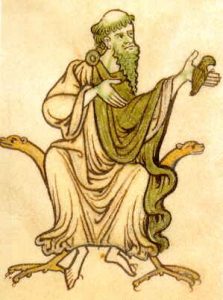I’ve just started birding, and it is teaching me a lot about listening. I’m in a beginner’s ornithology field class. It started in the cold, early spring when the trees were still bare here in the Northeast. That was good. The birds were in plain view, even if at a distance through binoculars and scopes. So we quickly started learning their names, colors, and markings. But now, in the early summer, the trees are fully leafed, the oak, maple, locust and basswood trees making an impenetrable green wall. Almost all we have now are the sounds. It was maddening at first, a cacophony of random calls and no easy way to know who’s who.
 But I am learning to focus my hearing, more than my binoculars these days. Best now to stand in one spot and strain to hear, to listen deeply. I love being with someone whose ear is trained and can guide me into this soundscape. What sounds to me to be various squawks and cheeps, to the trained ear are each distinct vocal signatures…a chipping sparrow, a goldfinch, a chickadee. I am starting to be able to discern the everyday familiar sounds and to catch, from time to time, the unusual snippet of a song, the arrival of an unfamiliar bird and an opportunity to learn.
But I am learning to focus my hearing, more than my binoculars these days. Best now to stand in one spot and strain to hear, to listen deeply. I love being with someone whose ear is trained and can guide me into this soundscape. What sounds to me to be various squawks and cheeps, to the trained ear are each distinct vocal signatures…a chipping sparrow, a goldfinch, a chickadee. I am starting to be able to discern the everyday familiar sounds and to catch, from time to time, the unusual snippet of a song, the arrival of an unfamiliar bird and an opportunity to learn.
I’ve also learned about the spring migration, with many species flying a thousand miles or more from their tropical winter homes to be with us for the summer, and then return. This has been called the pulse of the living planet. On a single day in May, 15,000 birders from 145 countries in the online “eBird” community, counted 6,242 species and recorded their locations.
The early Celtic Christians seemed to have ears well trained for listening. Deep listening. Even extreme listening. My favorite birder is St. Kevin. His beloved place was Glendalough, with its lakes and cliffs, south of Dublin. One morning in the early 500s he lifted his hands in prayer. It is said that in the stillness and openness of his prayer, God invited a blackbird to nest there in his open palm. She even lay eggs. And Kevin, in deep contemplation and in compassion for the creatures, kept his pose for weeks until the eggs hatched, and the chicks grew and finally took flight out beyond his loving hand.
Stillness, openness, appreciation of the familiar, being ready for the unexpected — I’m learning these lessons from birding, from Kevin, and from those straining to listen more deeply to God and to each other.
Seamus Heaney, winner of the 1995 Nobel Prize in Literature, reads his poem, “St. Kevin and the Blackbird”
John Finn is an engineer, climate change educator, and church servant-leader. He was a contributing author to Secular Monasticism: A Journey which is the story of the Lindisfarne Community in Ithaca, New York, where he was ordained. Current projects include engineering with AguaClara sustainable water treatment, and public speaking with Citizen’s Climate Education. He lives in Ithaca with his wife and two grown children. John worships with Living Hope Fellowship and loves making maple syrup and kayaking on Cayuga Lake.

1 comment
John, Thanks for this wonderful reflection. I felt like I was out there with you wandering with a friend and listening to the birds. Now you have me listening more intently to the various bird-songs that surround me everyday! Not sure I’ll be praying with one hand out the window though.